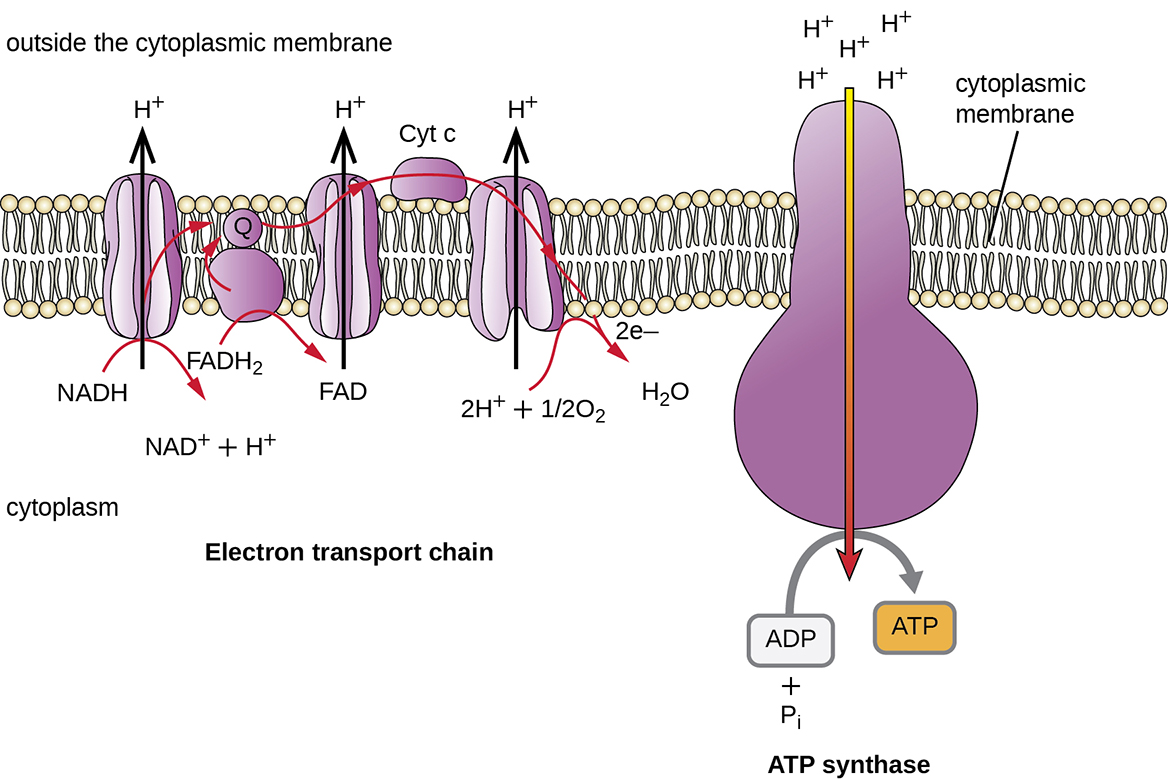Final Electron Acceptor in Aerobic Respiration
Rather an inorganic acceptor such as sulfate SO 4 2- nitrate NO 3 or sulfur S is used. The series of reactions is typically shorter in anaerobic respiration and uses a final electron acceptor such as sulfate nitrate sulfur or fumarate instead of oxygen.

Biochemistry Pyruvate As A Final Electron Acceptor In The Electron Transport Chain Biology Stack Exchange
The final electron acceptor is not the molecular oxygen as in aerobic respiration.
. Because of this oxygen is also called as the final electron acceptor. They will obtain energy through aerobic respiration. In this reaction lactic acid replaces oxygen as the final electron acceptor.
The oxygen molecule in aerobic respiration acts as the final electron acceptor resulting in the efficient production of ATP. The oxygen is the final electron acceptor of what is known as the electron transport chain found in the last stage oxidative phosphorylation of aerobic cellular respiration. Aerobic respiration produces a total of 38 ATP molecules per one molecule.
Denitrification is an anaerobic process which converts nitrate to dinitrogen in the following sequence. The electrons are passed onto electron carriers which are embedded within the inner mitochondrial membrane and travel along a series of. Oxygen is the final electron acceptor in aerobic respiration.
It is a process when glucose is broken down to carbon dioxide in the presence of oxygen to produce energy in the form of ATP. And respiratory chain complexes that mirror aerobic respiration in bacteria. But where does it exactly fit in the picture.
Need oxygen as the final electron acceptor in the electron transport chain and must have adequate oxygen in their immediate atmosphere in order to grow. It is also called fermentation. Oxygen combines with electrons and hydrogen ions to form water one.
The electron carriers deposit the electrons at the beginning of the chain and then through a process called chemiosmosis produce many ATP. Oxidative phosphorylation is the fourth and final step in cellular respiration. It is a process when glucose is broken down in the absence of oxygen.
Anaerobic respiration also produces less ATP for each sugar molecule digested than aerobic respiration making it a less efficient method of generating cellular energy. Basically oxygen can be found at the end of the ETC during aerobic respiration where it accepts electrons while picking up protons in order to produce water molecules. Oxidative phosphorylation OXPHOS is defined as an electron transfer chain driven by substrate oxidation that is coupled to the synthesis of ATP through an electrochemical transmembrane gradient Figure 131Historically bovine heart mitochondria have been the system of choice for the structural characterization of eukaryotic OXPHOS complexes Saraste 1999 because they.
For example because erythrocytes red blood cells lack mitochondria they must produce their ATP from anaerobic respiration. Aerobic respiration is the most efficient type of cellular respiration which occurs in most eukaryotes and some prokaryotes. The terms aerobic respiration anaerobic respiration and fermentation substrate-level phosphorylation do not refer to primary nutritional groups but simply reflect the different use of possible electron acceptors in particular organisms such as O 2 in aerobic respiration or nitrate NO 3 sulfate SO 2.
Oxygen provides a force to drive the transport of electrons down the chain. Different types of organisms use different types of final electron acceptors. This transfer of electrons from lower to higher redox potential continues until it reaches the final electron acceptor.
NO 3 NO 2 NO N 2 O N 2This dissimilatory process the end product is not assimilated into biomass in which nitrate is used as final electron acceptor in anaerobic respiration is carried. Which is referred to as the final electron acceptor. Oxygen is an essential molecule in cellular respiration.
For the electron transport chain to continue working there must be a final electron acceptor. If that acceptor is oxygen the process is considered aerobic respiration. Mitochondria have two membranes the inner.
Anaerobic respiration occurs in most cells of the body when oxygen is limited or mitochondria are absent or nonfunctional. For anaerobic respiration NO 3 SO 4 2 CO 2 or fumarate can serve as terminal electron acceptors rather than O 2 depending on the. Organisms such as Pseudomonas spp.
Respiration takes place when any organic compound usually carbohydrate is oxidized completely to CO 2 and H 2 O. If in an environment without oxygen they will turn to fermentation to satisfy. Anaerobic respiration is used by microorganisms called archaea in which neither oxygen aerobic respiration nor pyruvate derivatives fermentation is the final electron acceptor.
These can be sulfate ions nitrate ions or carbon dioxide. Madsen in Encyclopedia of Ecology 2008 Denitrification. Cellular respiration is of two types ie.
An important metabolic role of environmental oxygen is to serve as a terminal electron acceptor for the regeneration of NAD via mitochondrial respiration to support cellular oxidation reactions. In the electron transport chain electrons from NADH and FADH2 are transferred to an electron acceptor having a higher redox potential. Methanogenic bacteria are one such type of organisms that use carbon dioxide as the final electron acceptor in the absence of.
In aerobic respiration molecular O 2 serves as the terminal acceptor of electrons. Aerobic respiration and anaerobic respiration. The ultimate acceptor of these high-energy electrons is oxygen and therefore oxidative phosphorylation generates both ATP and water.

Aerobic Respiration Equation In Plants
What Is The Terminal Electron Acceptor In Aerobic Cellular Respiration Quora

Aerobic Respiration And Anaerobic Respiration Diagrams Definition And Differences Laboratoryinfo Com

No comments for "Final Electron Acceptor in Aerobic Respiration"
Post a Comment